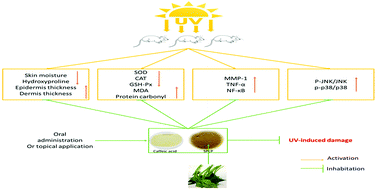Photoprotective effects of sweet potato leaf polyphenols and caffeic acid against UV-induced skin-damage in BALB/C nude mice†
Abstract
This study aimed at clarifying the mechanism by which sweet potato leaf polyphenols (SPLPs) ameliorate ultraviolet (UV) radiation damage, using the BALB/c hairless female mouse model. The moisture and hydroxyproline (HYP) contents of the model mouse skin and the thickness of the epidermis and dermis were determined by staining and histological examination. Anti-oxidative enzyme activities, malondialdehyde (MDA) content, and protein carbonyl content in skin tissue and serum were investigated. Expression of inflammatory markers and mitogen-activated protein kinase signaling pathways were evaluated. Topical caffeic acid at 30 mg kg−1 most strongly inhibited the decrease in skin moisture, HYP content, and the thickening of the epidermis. Topical SPLP at 100 mg kg−1 most significantly inhibited the dermal thickening, increased the activities of the superoxide dismutase, catalase as well as glutathione peroxidase, and decreased the content of serum MDA and protein carbonyls markedly. Furthermore, the topical SPLP suppressed the UV-induced rise in the inflammatory markers MMP-1, TNF-α, and NF-κB, and alleviated phosphorylation levels of the stress-signaling proteins JNK and p38. Thus, topical SPLP provided the best overall protection for mouse skin from UV-induced damage.



 Please wait while we load your content...
Please wait while we load your content...